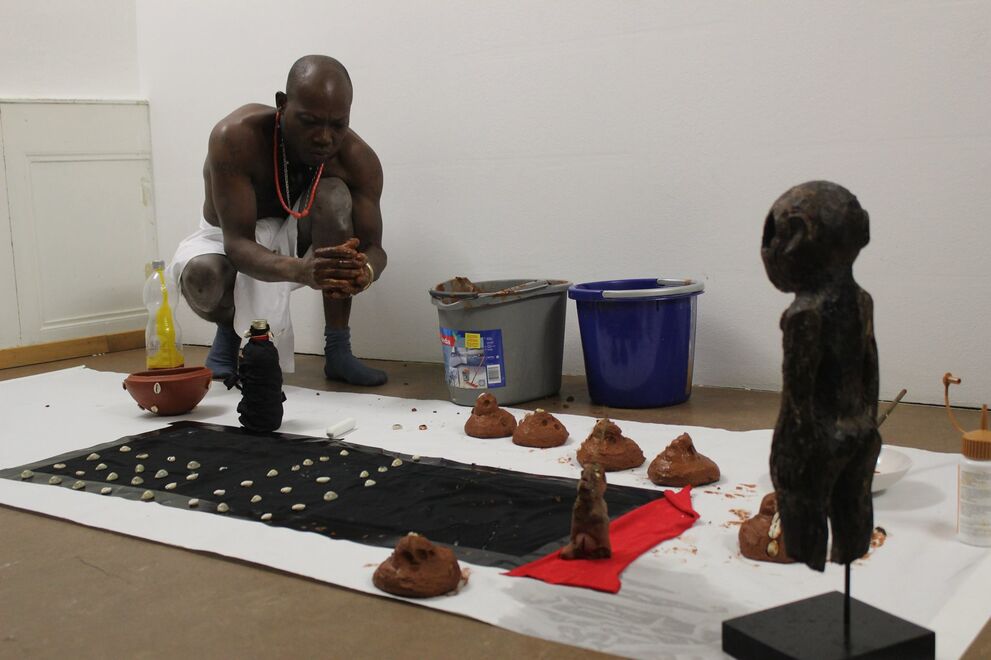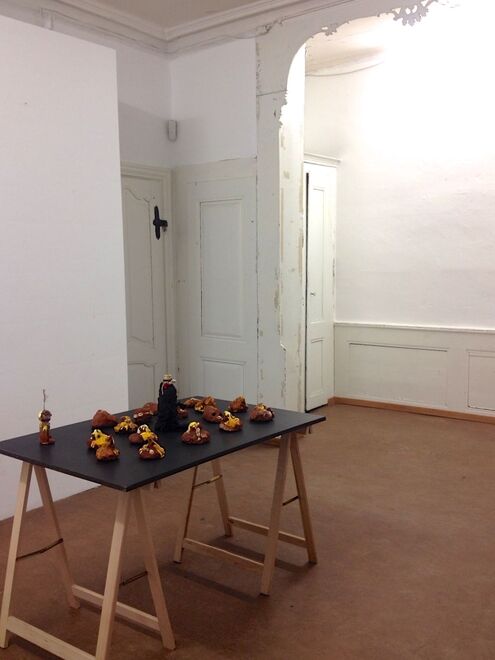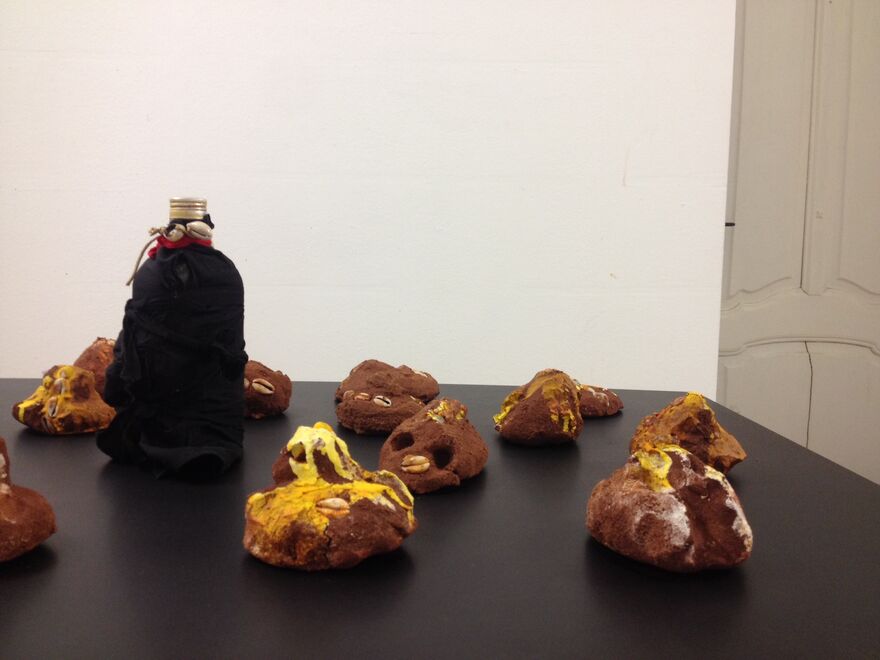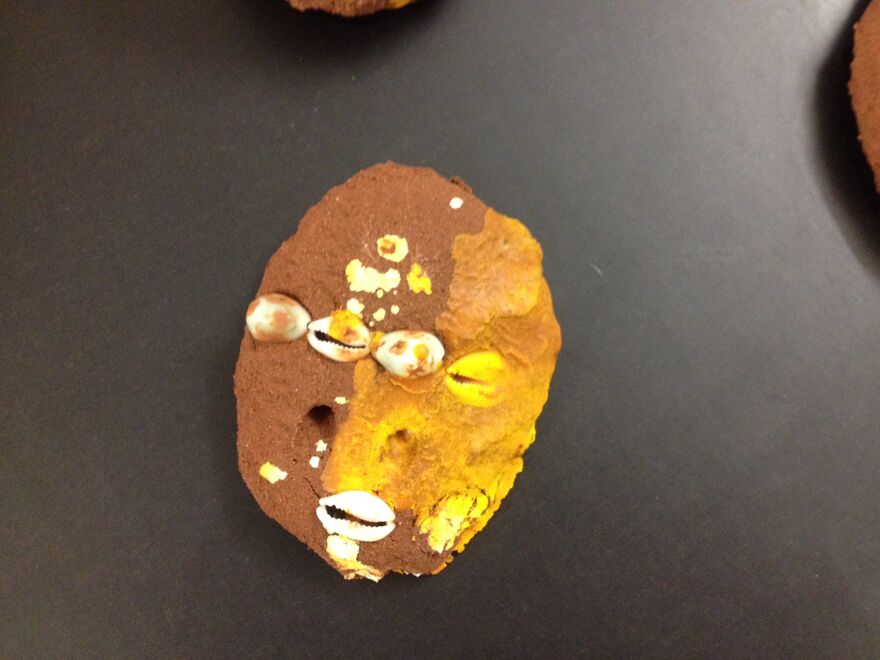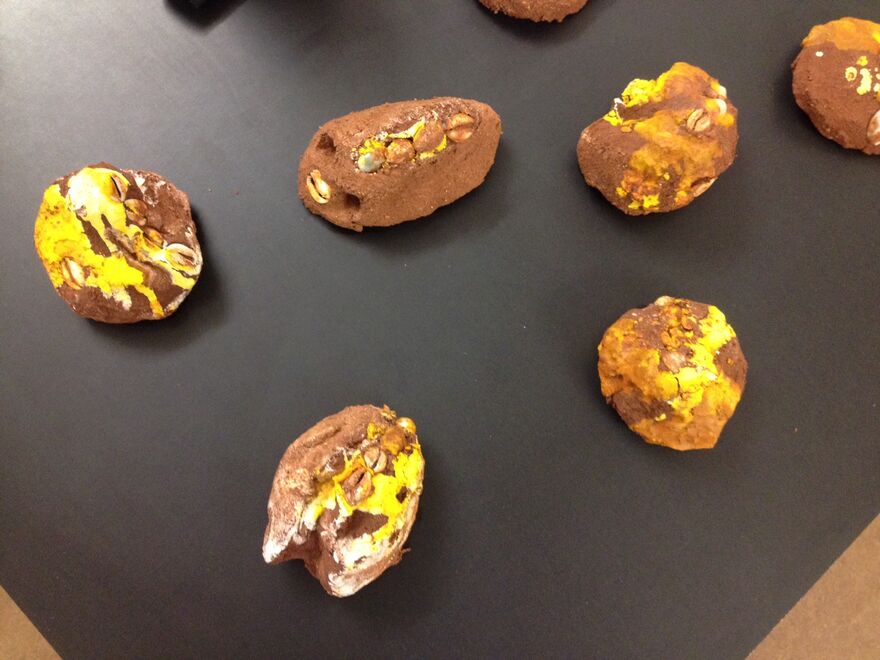Kiffouly Youchaou / Fa, vodoun et la politique africaine
Die ausgestellten Objekte sind das Produkt eines Performance-Rituals des Künstlers Kiffouly Youchaou aus Benin: "Fa, vodoun et la politique africaine". Im Rahmen des BONE Performance Festivals entstand im /Projekt Links/ unter dem Titel Ausgerenkte Kräfte / Dislocated Forces ein Dialog zwischen Kraftobjekten aus Mali, Benin und Nigeria aus der Sammlung Henri Racz und Künstlern des BONE Performance Festivals (30. November - 4. Dezember 2016). Das Thema des diesjährigen Festivals war neoneoDADAfrica!, mit Schwerpunkt Performance Art aus Afrika, im Spannungsfeld von Kunst - Ritual - Performance.
Die Objekte aus Tonerde entstanden in einem Vodoo Ritual in dem der Künstler seine eigene Position in Bezug auf Holzfiguren aus dieser in seiner Heimat Benin verbreiteten Religion reflektierte und aufführte. Er schuf neue Kraftobjekte, die im Umgang mit den alten Figuren, die über ihre Entstehung wachten, neu aufgeladen wurden.
Die Objekte können gekauft werden. Damit erwirbt man aber nicht nur ein Ding, sondern auch eine gewisse Macht, die von ihm ausgehen kann. Der Künstler in seiner Rolle als Schamane kann durch das Objekt auch helfen, Probleme zu lösen. Erwirbt man ein Objekt und sollte man in seinem Leben ein Problem haben, kann man den Künstler anrufen, der dem Käufer entsprechend dem Objekt in seinem Besitz sagen wird, was sie zu tun haben um das Problem zu lösen.
Über die Vodoo-Figuren aus Benin, die in der Performance aktiv eingesetzt wurden (Englisch):
Vodun (Voudoun or Voudou) is a religion practiced by various people of the Gbe speaking ethnic groups of Western Africa, in Ghana, Togo and Benin. Vodun cosmology centres on the vodun spirits and other elements of divine essence that govern the Earth.
Wooden figures known as bocio (from bo, ‘charm’, and cio, ‘corpse’) play an important part in this religion. The vodun spirits — which range from major deities that govern the forces of nature an human society to the spirits of individual streams, trees, and rocks — are said to charge the bocio with different powers. Their purpose is to drive away or lay traps for evil, and to control the forces of the gods, the ancestors and the spirits. They have all kind of material to help them do this — iron objects, string, beads, cowrie shells, horns, animal skulls and pieces of cloth. Sometimes sacrifices such as grains or animal blood are applied to the surface of the object to strengthen its power.
Bocio is a collective term for figures that can take on different functions. For example the Kudio Bocio (the less obviously anthropomorphic of the two figures shown here) are identified as atavistic "sentinels" for the protection of a village, a family or an individual. They serve as ‘lightening conductors’ for their owners by warding off evil forces and influences. This particular Kudon Bocio has been heavily sacrificed to, if you look closely you can see traces of different substances on its surface.
Hier finden sie Informationen zu allen Objekten aus der Sammlung Racz, die während dem Festival gezeigt wurden: Download Pdf.
Performance von Marcellina Oseghale Akpojotor , 1. Dezember 2016
"Of Swirls and Curves, Power and Ruin”, performance by Marcellina Oseghale Akpojotor at 19 Bone Performance Art Festival, Gerechtigkeitsgasse / Galerie DuflonRacz, December 1, 2016.
Marcellina explained that the performance focuses “on the harms of electronic wastes on humanity and the environment. The Emission from the informal recycling method often employed damages human health and pollutes the environment. It also touches on the connection between the earth and human lives for as the earth rotates life is sustained and in spite of this we continue to disregard and torture her consciously and unconsciously. According to a report by the United Nations University 41 million tones of electronic waste worth over $50 billion was discarded all over the world in 2014 and only 6 million tones was recycled properly. Hence, this e-waste from Europe find their way to Africa and Asian countries and Nigeria been one of them is fast becoming a dumping site for most of these e waste often disguised as second hand goods commonly called "tokunbo" in Nigeria. The E-waste contains hazardous materials like mercury and heavy metals like nickel, cadmium and chromium, which is harmful to our lives and our environment. Young men, women and children are found on the dumpsite scavenging for valuable metals worth selling and in so doing expose themselves to the hazard of these electronic wastes. From the informal recycling methods employed like open burning, a lot of damage is done to the environment, polluting the soil and water. Some of these people are unaware of the hazardous nature of this activity”.

